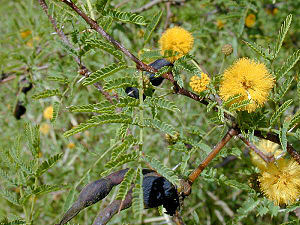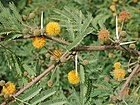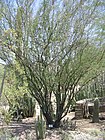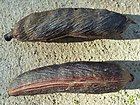Note: This is a project under development. The articles on this wiki are just being initiated and broadly incomplete. You can Help creating new pages.
Difference between revisions of "Acacia farnesiana - Vitkhadira"
(→Mode of Propagation) |
(→References) |
||
| Line 74: | Line 74: | ||
<ref name="Uses">[https://easyayurveda.com/2016/05/04/irimeda-arimeda-acacia-farnesiana/ Uses]</ref> | <ref name="Uses">[https://easyayurveda.com/2016/05/04/irimeda-arimeda-acacia-farnesiana/ Uses]</ref> | ||
| − | <ref name="Leaf">[http://keralaplants.in/ | + | <ref name="Leaf">[http://keralaplants.in/ Botanic description]</ref> |
<ref name="Common names">[http://envis.frlht.org/bot_search "Vernacular names"]</ref> | <ref name="Common names">[http://envis.frlht.org/bot_search "Vernacular names"]</ref> | ||
Revision as of 12:33, 17 June 2019
Vitkhadira is a small, spiny, much-branched, deciduous shrub or tree with a wide, low crown; it can grow 2 - 7 metres tall. The short, crooked bole can be 15 - 35cm in diameter. The plant can form dense, spiny thickets. A multipurpose tree with a wide range of uses as a food, medicine, perfume and source of materials.
Contents
- 1 Uses
- 2 Parts Used
- 3 Chemical Composition
- 4 Common names
- 5 Properties
- 6 Habit
- 7 Identification
- 8 List of Ayurvedic medicine in which the herb is used
- 9 Where to get the saplings
- 10 Mode of Propagation
- 11 How to plant/cultivate
- 12 Commonly seen growing in areas
- 13 Photo Gallery
- 14 References
- 15 External Links
Uses
Oral problems, Diarrhea, Inflammation, Cough, Itching, Urinary tract disorders [1]
Parts Used
Chemical Composition
Common names
| Language | Common name |
|---|---|
| Kannada | byadala gida, jaali, kashturi, karijali, kasturi jaali |
| Hindi | durgandhakhair, gandhi-babul, guhbabul, pissibabul |
| Malayalam | kariveelum, pauvelam, pikharu-vil |
| Tamil | arimetam, kacappuppivelamaram, kasturivel, kirimetam, peyvel |
| Telugu | arimidamu, kampu tumma, kasthoori thumma, murikitumma, piyyathumma |
| Marathi | NA |
| Gujarathi | NA |
| Punjabi | NA |
| Kashmiri | NA |
| Sanskrit | arimedah, godhaskanda, kalaskandha, Vitkhadir |
| English | cassie |
Properties
Reference: Dravya - Substance, Rasa - Taste, Guna - Qualities, Veerya - Potency, Vipaka - Post-digesion effect, Karma - Pharmacological activity, Prabhava - Therepeutics.
Dravya
Rasa
Tikta (Bitter), Kashaya (Astringent)
Guna
Laghu (Light), Rooksha (Dry)
Veerya
Sheeta (cold)
Vipaka
Katu (Pungent)
Karma
Pitta, Kapha
Prabhava
Habit
Identification
Leaf
| Kind | Shape | Feature |
|---|---|---|
| Bipinnate | alternate | Leaves ca. 5 in a cluster, 2-7 cm; pinnae 5 pairs, 1-2.5 cm; leaflets 10-15 pairs, elliptic, 5 x 1 mm, overlapping, glabrous, base truncate, margin entire, apex obtuse; nerves prominent below; petiole to 1.5 cm, with a gland near the middle; rachis stiff-pubescent, eglandular; stipular thorns unequal, to 2 cm, straight. |
Flower
| Type | Size | Color and composition | Stamen | More information |
|---|---|---|---|---|
| Bisexual | axillary globose heads | yellow | Many | Flower-heads globose, 8 mm across, 2 or 3 in axillary cluster, to 2 cm; peduncle densely stiff-pubescent, with involucel of bracteoles at the base. Flowers 2 mm across. Calyx-tube 5-toothed, to 1.5 mm. Petals 5, yellow, to 2 mm. Stamens numerous, to 4 mm, basally connate. Ovary stipitate, terete, to 1 mm; style to 3 mm. |
Fruit
| Type | Size | Mass | Appearance | Seeds | More information |
|---|---|---|---|---|---|
| A Pod | 5 x 0.5 cm | pulpy, turgid, glabrous, obtuse at apices, horned | seeds 20 or more, globose, 0.5 mm, 2-seriate. | {{{6}}} |
Other features
List of Ayurvedic medicine in which the herb is used
Where to get the saplings
Mode of Propagation
How to plant/cultivate
Seeds germinate readily. For faster germination, they may be scarified and soaked in water overnight before sowing.
Commonly seen growing in areas
Tropical area, Sub tropical areas.
Photo Gallery
References
External Links
- Ayurvedic Herbs known to be helpful to treat Oral problems
- Ayurvedic Herbs known to be helpful to treat Diarrhea
- Ayurvedic Herbs known to be helpful to treat Inflammation
- Ayurvedic Herbs known to be helpful to treat Cough
- Ayurvedic Herbs known to be helpful to treat Itching
- Ayurvedic Herbs known to be helpful to treat Urinary tract disorders
- Herbs with Stem used in medicine
- Herbs with Bark used in medicine
- Herbs with Heartwood used in medicine
- Herbs with common name in Kannada
- Herbs with common name in Hindi
- Herbs with common name in Malayalam
- Herbs with common name in Tamil
- Herbs with common name in Telugu
- Herbs with common name in Sanskrit
- Herbs with common name in English
- Habit - Shrub or small tree
- Index of Plants which can be propagated by Seeds
- Index of Plants which can be propagated by Cuttings
- Herbs that are commonly seen in the region of Tropical area
- Herbs that are commonly seen in the region of Sub tropical areas
- Herbs
- Shrub
- Fabaceae




